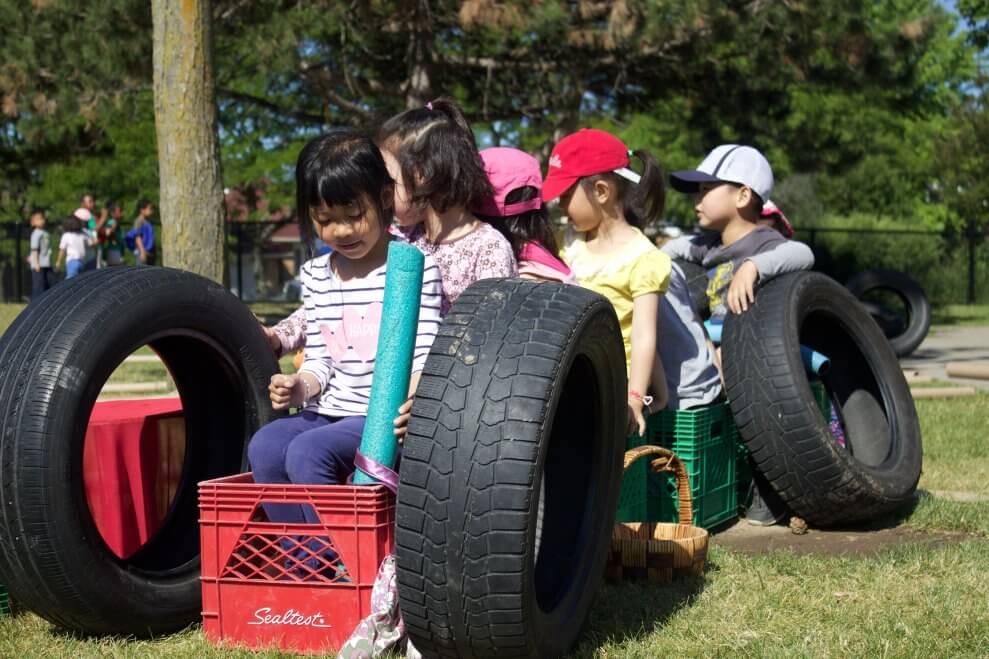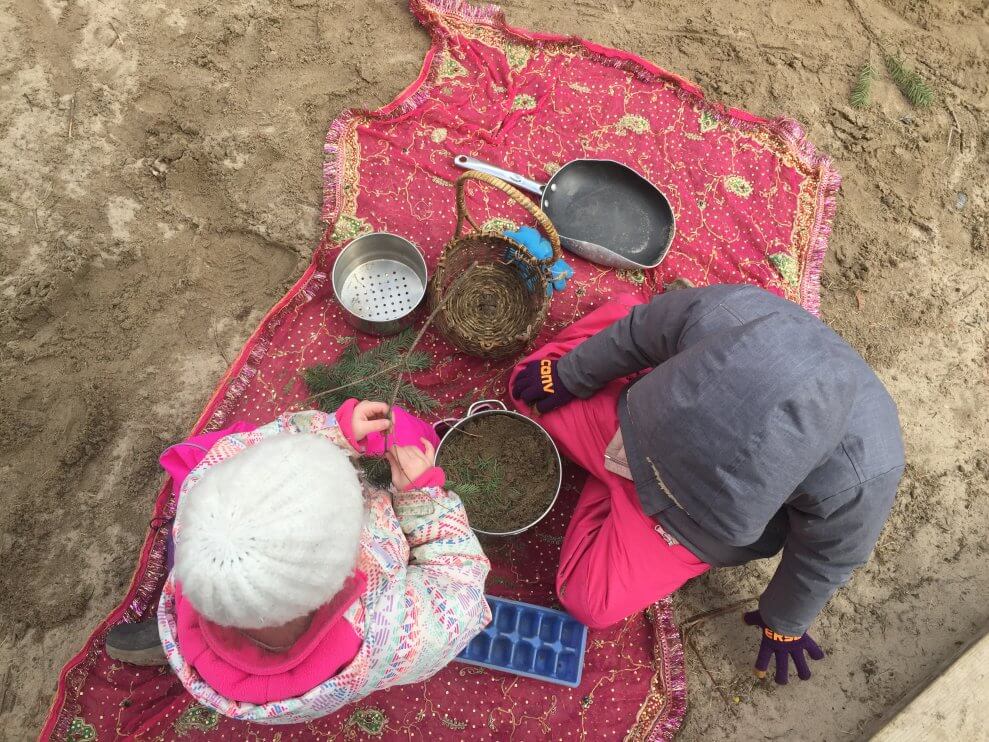
The power of play: Why outdoor child-led movement at school is important
The play yard at Kensington Community School in Toronto is a buzz of creative activity and delighted chatter. On a small dirt-covered hill, two children excavate with dented aluminum pots and prod the earth with trowels. Across the yard, a tarp is held taut by bits of fabric crisscrossed through tires piled high in a makeshift fort/ship/bear’s den. And two young friends hold hands as they leap off milk crates into inviting muddy puddles left over from the previous day’s rain.
The school is one of 40 in the Greater Toronto Area (GTA) that have implemented Outdoor Play and Learning (OPAL), a program established in the United Kingdom in 2006 by Michael Follett. In 2016/2017, OPAL worked in partnership with Earth Day Canada (subsequently EcoKids) to deliver the OPAL program to six Canadian schools through a pilot program with the Toronto District School Board. Since that successful initiation, the program has now grown to reach public elementary schools at three GTA school boards.
The OPAL program
The OPAL program is available to elementary schools with grades K‑8 and offers strategic ways of improving opportunities for child-directed outdoor play throughout the day. Over the span of approximately 18 months, an OPAL mentor guides and supports administrators, parents, teachers, daycare supervisors, and support staff in implementing the program. OPAL mentors facilitate play days, educational workshops, and parent outreach. The result is an outdoor play policy where unstructured outdoor free play is an integral part of the school day.
The program focuses on healthy and engaging play opportunities for all students—including those in older grades—and recognizes that play is developmentally important and a right of all children.
“We try to focus on the definition of play being self-directed, freely chosen, and intrinsically motivated,” says Linda Naccarato, an outdoor education consultant and OPAL program mentor based in Toronto. “We focus on the role of the adults as that of a person who supports an environment for play rather than directing it.”

Initial findings
Over two years, Ryerson University’s School of Urban and Regional Planning studied the pilot programming [PDF] and its impact on students and school communities. Some key findings of the report indicated that with OPAL outdoor play, kids had become more engaged, inclusive, and imaginative, and the programming created opportunities for children to remain physically active for longer periods of time. It was noted that children were doing better with cooperative play and negotiating with each other while playing, and play between different ages and genders had become more common.
The report also found parental attitudes changed throughout the study, with higher levels of parental support for outdoor play in 2019 compared to 2016, and 13% more parents encouraging outdoor play.
Active and engaged students
Former principal Dan Fisher brought the program to Kensington Community School in 2016. (At a new school in 2021, he was pleased to report that it had already started working with OPAL.)
When OPAL was implemented at Kensington, Fisher says he saw a positive change in the school community. Initially, the concept may have “raised a few eyebrows,” he says, but staff also saw the value in making outdoor play and learning part of every child’s day.
The school saw a decrease in bullying and conflicts on the playground. “When kids are engaged in classrooms, they work harder and better. When kids are engaged on the playground, they don’t have time to wander around in herds and bully each other,” says Fisher.
He notes that research done across a number of settings showed that loose parts play increases the level of vigorous physical activity on a playground.
“If you want your kids to be healthier and more focused in class, physical activity is the way to get there. Loose parts play provides that over and above what you’re going to get from all the traditional stuff that we usually offer.”

Loose parts and risky play
In traditional elementary school playgrounds, play is generally restricted to fixed post-and-platform structures, and equipment for competitive group sports. With their narrowly defined functions, children’s options and opportunities for creative active free play are limited.
At OPAL schools, loose play materials are added to the playgrounds, and playtime becomes purposeful, social, and imaginative. Each school’s outdoor environment and space is different, so OPAL mentors focus on what works for individual communities, staff, and students—and the additional challenges of Canadian weather.
“There are some really common loose play items like old pots and pans and kitchen equipment, tires, or wood planks,” says Naccarato. “There’s a lot of conversations that happen beforehand to make sure everyone’s onboard and understands and feels comfortable; both with what the play looks like and how students are managing risks. Because in that risky or challenging behavior or play, there’s a lot of really great learning.”
“There are a lot of adults in charge of playgrounds and they tend to confuse hazards with risks and end up making playgrounds as safe as possible, as opposed to as safe as necessary,” adds Fisher. “When we try to design playgrounds that work well for adults, we end up with playgrounds that don’t work well for children.”
Whole-body benefits
ParticipACTION’s 2020 Report Card on Physical Activity for Children and Youth reported alarming statistics during the past year of COVID-19 restrictions. It found that only 4.8% of children (ages 5-11) and 0.8% of youth (ages 12-17) were meeting 24-hour movement behaviour guidelines, while 62% of kids and teens were being less physically active outdoors.
Research worldwide has demonstrated the profound benefits that playing outside, and especially unstructured outdoor play, can have on all aspects of children’s development. This type of play allows children to explore and find connections to the natural world, and improve overall social skills, creativity, focused attention, and collaborative play. Children’s play is especially essential during times of stress and uncertainty, such as the current global pandemic crisis.
“The Canadian Healthy Schools Alliance recognizes that outdoor play opportunities are an integral part of a child’s learning experience at school. OPAL’s approach in terms of engaging the school community to identify the needs and assets, and to implement an outdoor play and learning programs are well aligned with Healthy Schools. Students are more likely to adopt healthy active living practices when healthy-school policies and healthy practices are reinforced by schools, families and communities.”
-Katelynn Theal, assistant director, Comprehensive School Health, Ever Active Schools
A gradual rollout
The OPAL program develops with a staggered rollout to the school community to explain the benefits of child-led outdoor play, and transform attitudes to risk and supervision.
“At the beginning, we’ll encourage schools to do some sort of outreach for the greater school community, whether that’s a parent council meeting, or maybe a play day event where families are invited to attend,” says Naccarato. “We look at planning in terms of the mental health and well-being benefits, the physical benefits, the benefits in terms of resiliency and confidence.”
Kensington Community School phased the program in slowly, first adding plastic trowels and small items, and then tires donated by a local garage. “It was a long transition,” says Fisher. “I wouldn’t recommend you just put a dump truck of loose play parts on your playground and say, ‘Have at it.’ But if you start with kids’ natural inclinations and build from there, you’re going to end up with a winner.”
OPAL during the school day
When first rolled out, the program is generally constrained to the day’s recess periods, or before and after school, then subsequently included in more of the school day.
“What we typically see is that teachers see connections to the curriculum, or play comes back into the classroom because they’re extending ideas,” says Naccarato. “If students have explored outside—whether they were building a structure, or telling us a fantastic story—teachers will use play as a jumping-off point and then find really creative ways to link it to their lessons. So we have had schools where the same loose parts that are available for play are used in a science lesson about simple structures, or in a math lesson.”
OPAL also encourages inclusive play between students of different abilities, skills, and ages. “We see the bigger kids playing with the younger kids, and the kids from our four autism programs can sort of slip in and out of any activity that’s going on because it’s not about athletic ability and the sort of pecking order that you’d get on a traditional playground,” says Fisher.
He found that the impact of loose parts play had a profound impact on Kensington’s culture. “Loose parts play is based upon an optimistic stance and a fundamental trust that the leader has in the staff, and that the staff has in the kids, and it becomes a metaphor for the entire school.”
Internationally, OPAL has been implemented across the U.K. and in Australia, New Zealand, Poland, Spain, and France. It’s won several awards including Best European Active Schools program in 2018, several U.K. national awards, and is recognized as a best practice for supporting school improvement through play.
For more information on OPAL, Canadian educators can reach out to Linda Naccarato at [email protected].
Photos courtesy of EcoKids.






anyone know who to get in touch with at OPAL to implement a similar program in a school?
Thank you